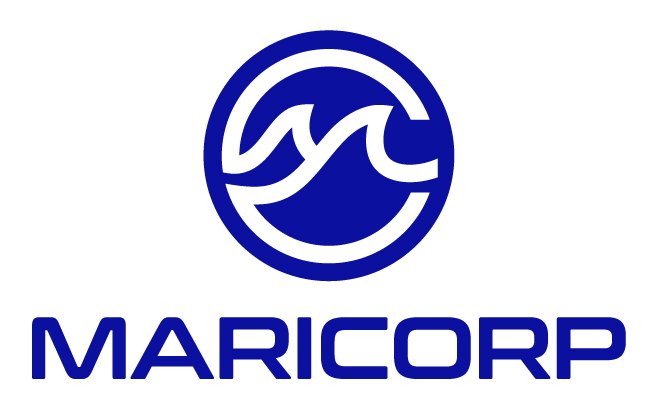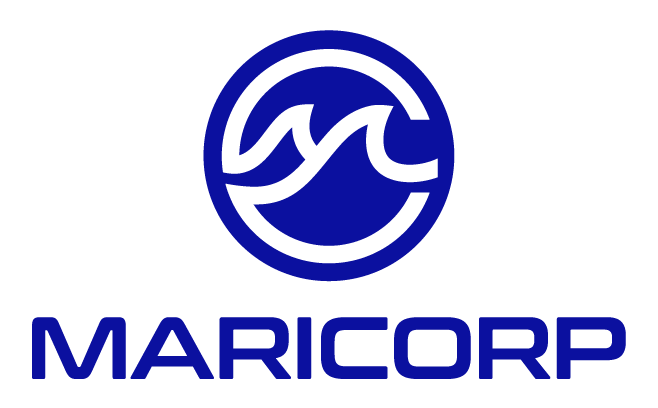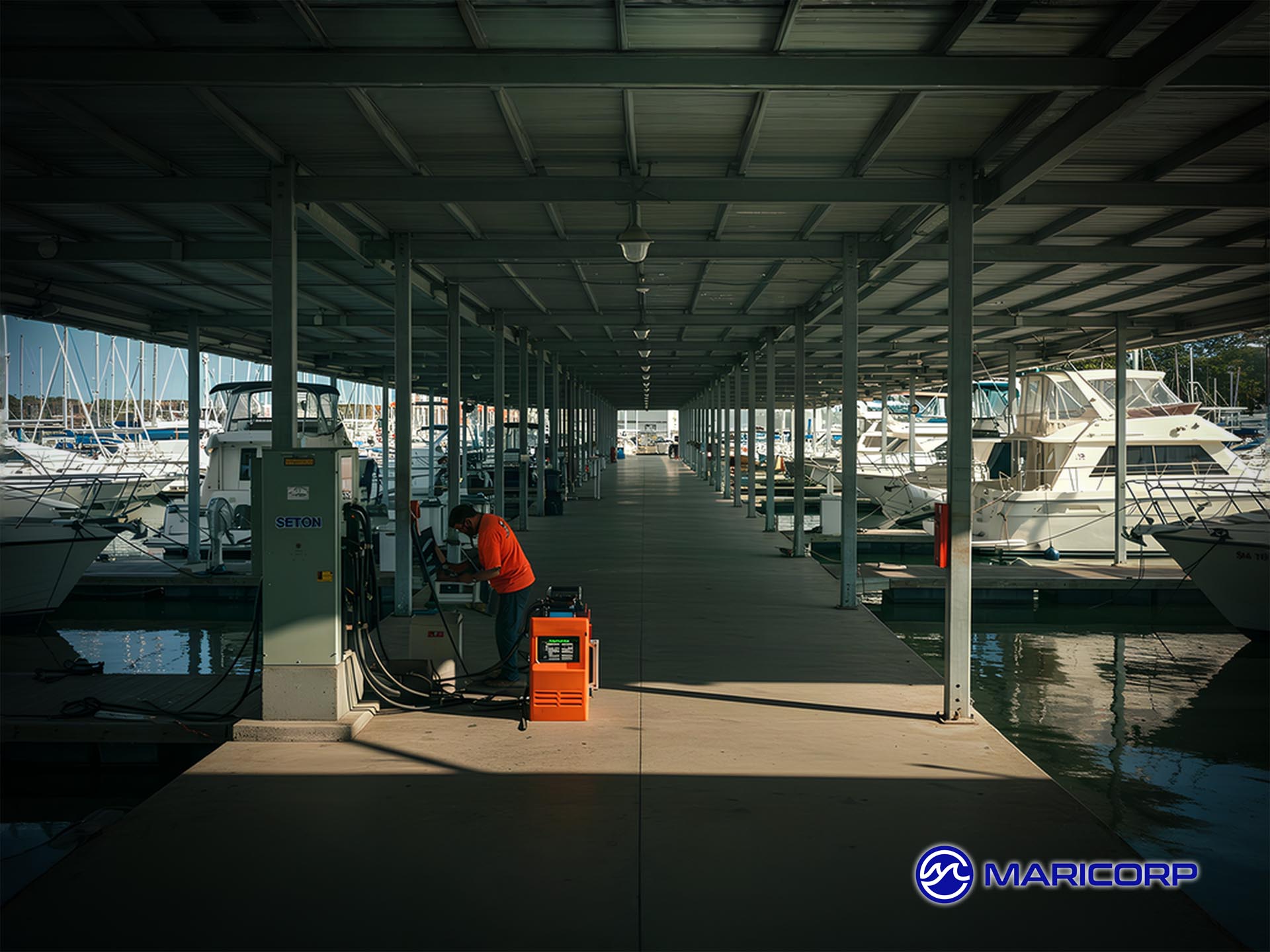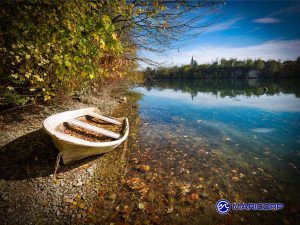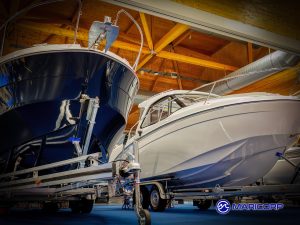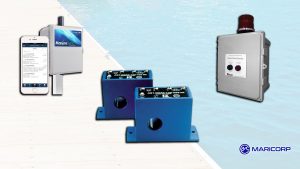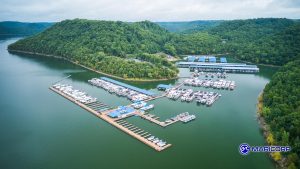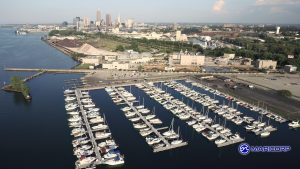10 End of Summer Marina Maintenance Tips
Late summer marks the end of peak dock use, ideal timing for a thorough inspection. It’s also the right moment to begin removing boat lifts, ladders, and furniture for off season storage to protect them from the elements. Extended sun exposure, wave action, and marine growth can accelerate wear on dock structures and hardware during the high season.
1. Inspect Docks and Pilings for Damage
Freshwater marinas are not immune to long term corrosion, especially where moisture accumulates in seams or under decking. Galvanized bolts and connectors may appear visually intact but could be rusting from the inside out. Additionally, freshwater lakes often experience water level fluctuations caused by dam operations or drought conditions, which can put added stress on pilings, gangways, and anchoring hardware.
Common late summer issues include rot, rust, warped decking, and corrosion, especially in areas exposed to waterline fluctuations or poor drainage. In some freshwater environments, zebra mussels and algae growth can accumulate on pilings or floats, creating slippery surfaces and hidden damage. These should be cleaned regularly to prevent structural wear and reduce liability risks.
To stay ahead of structural issues:
- Remove and store any removable dock features like benches, ladders, or decorative items.
- Inspect seawall foundations and pilings for signs of wood rot, corrosion, or marine borer activity.
- Tighten or replace hardware showing rust, fatigue, or movement from wave action.
- Check for shifting or settling foundations in fixed docks or gangways.
Marina maintenance tips: Document every item in a photo checklist, especially safety related issues like:
- Loose cleats or unstable bumpers
- Warped or cracked decking
- Worn out fenders or rub rails
- Loose connections in floatation systems
- Signs of erosion around bulkheads or shoreline reinforcements
For freshwater facilities, pay special attention to:
- Galvanized or aluminum surfaces that show white oxidation or rust staining
- Anchoring systems stressed by seasonal water level drops
- Organic debris collecting under docks or inside floatation chambers
2. Test Electrical Hookups and Pedestals
As summer winds down, marina electrical systems need close inspection. Heat, humidity, storms, and both salt and freshwater exposure accelerate wear on shore power pedestals and wiring. Even in freshwater marinas, moisture buildup can degrade connectors and accelerate deterioration.
Key inspection points:
- Conduct a visual walkthrough of each pedestal, checking for rust, oxidation, cracked covers, loose breakers or GFCI outlets, and signs of insect or rodent activity.
- Remove covers and inspect internal components for green patina, moisture, or melting insulation, early signs of internal corrosion or overloading.
- Confirm ground resistance, especially in older installations or high use areas, to ensure NEC compliance and safe grounding.
- Ensure shore power cords are properly coiled and routed above walking surfaces to avoid tripping, abrasion, and pinching from dock movement.
During late season use and haul out periods, it’s especially important to inspect all connection points, cord ends, inlets, receptacles, and adapters, for corrosion, discoloration, or signs of overheating. Shore power cords should be kept off the dock surface and rinsed with freshwater if exposed to salt spray. After cleaning, apply a corrosion inhibiting spray to protect terminals from oxidation. These steps help reduce heat buildup and prevent loss of connection as equipment ages.
Marina maintenance tips to include:
- Monthly pedestal audits with recorded voltage, breaker status, and GFCI test results
- Application of corrosion inhibitor spray after cleaning exposed metal surfaces
- Scheduling a thermal (infrared) scan every 1–2 years to identify hidden hotspots
- Ongoing staff log entries documenting inspections, repairs, and any cables marked out of service
This proactive approach supports safety, helps prevent downtime or electrical faults, and ensures you close out the end of summer season with confidence.
3. Inspect Fuel Docks and Storage Systems
As the end of summer draws near, fuel dock maintenance should be a top priority. Months of intense use, rising temperatures, and frequent rainfall can expose weaknesses in your fuel delivery system and storage infrastructure. Now is the time to complete a detailed inspection before weather or downtime complicate necessary repairs.
Fuel docks are high risk zones, and small oversights can lead to costly spills or regulatory violations. Begin with a visual sweep of the entire fueling area. Look for signs of fuel staining, cracking in hoses, damaged seals around pump handles, or unsecured tank caps. Don’t forget to check for weathered or missing signage, especially around shutoff switches and emergency contact points.
Key actions to include:
- Inspect fuel hoses and nozzles for UV damage, brittleness, or loose couplings. Any hose that feels soft, cracked, or dry rotted should be replaced immediately.
- Verify drip containment systems are functional and intact beneath nozzles and hose cradles. Remove any standing fuel or water in containment trays.
- Test all emergency shutoff switches, ensuring they are clearly labeled, unobstructed, and operational.
- Check vent lines and overfill prevention systems on all storage tanks for blockages, corrosion, or unusual odors that may indicate vapor leaks.
Ensure all above ground and underground tanks are clearly labeled, securely locked, and equipped with weather resistant caps and gaskets. Any sign of water infiltration or sediment buildup in the fuel system should prompt a call to a certified technician.
Marina maintenance tips for fuel systems should also include:
- Reviewing recent inspection logs to catch patterns or repeated issues
- Scheduling tank integrity tests and water detection sampling
- Restocking absorbent pads, booms, gloves, and disposal bags in spill kits
- Posting spill response procedures and emergency numbers at every fueling station
Lastly, make sure your facility complies with the EPA’s Spill Prevention, Control, and Countermeasure (SPCC) regulations. If your marina stores more than 1,320 gallons of oil or fuel in above ground tanks, you are likely required to maintain a written SPCC plan, including secondary containment and designated transfer areas. Keeping this documentation updated can help prevent environmental damage and regulatory fines.
4. Check Waste Pump Out Systems and Sanitation Stations
At the end of summer, pump out stations often require close attention after heavy use throughout boating season. These facilities are key to protecting public health and marine ecosystems, and must remain reliable and compliant. Overlooking seasonal wear and tear can lead to backups, spills, and potential violations.
Start by carefully inspecting hoses, seals, and intake fittings. Any hose showing cracks or leaks should be immediately removed from service and replaced. Worn gaskets or loose clamps can allow unpleasant odors or leakage, timely repairs are essential.
Key end‑of‑season checks:
- Vacuum pumps and impellers – flush units with clean water; reduced suction usually signals seal wear or blockages.
- Holding tanks – clean and flush to remove sludge or debris that might clog valves or lines during storage.
- Backflow prevention valves – test operation to ensure they fully close and prevent reverse flow.
- User signage – ensure all instructions, labels, and emergency contact information are clean, legible, and securely posted.
Many marinas benefit from federal Clean Vessel Act grants for maintenance and operation of pump out systems. The U.S. Fish & Wildlife Service’s CVA program helps fund construction, renovation, and upkeep of these facilities, and encourages proper reporting and system operation, especially when end‑of‑summer maintenance is scheduled accordingly.
Marina maintenance tips for sanitation systems:
- Flush hoses and tanks annually with fresh water
- Store portable pump out units indoors during the offseason
- Test vacuum strength at each station before closing down
- Replace weather damaged signage immediately
- Log all servicing dates, fluid volumes pumped, and any user reported issues
Proactive end of season maintenance ensures environmental compliance, avoids unpleasant surprises next spring, and demonstrates your marina’s dedication to quality service and stewardship.
5. Maintain Stormwater and Drainage Infrastructure
As the end of summer nears, your marina’s stormwater and drainage systems deserve close attention. Heavy rains, debris buildup, and seasonal water level fluctuations can clog drains and damage infrastructure leading to flooding or pollution.
Stormwater runoff at marinas often contains hydrocarbons, detergents, antifreeze, and sediment. If not properly treated, these can flow directly into waterways. Now is the perfect time for a full site inspection and cleanup before cooler weather arrives.
Tasks to complete:
- Clean out storm drains and grates near parking areas, docks, and fueling zones, remove leaves, gravel, trash, and cigarette butts.
- Inspect culverts, swales, and benches for erosion or sediment buildup. Shoreline washout is common after summer storms.
- Maintain oil‑water separators by cleaning or replacing filters after heavy runoff events.
- Check diverters and downspouts on buildings, ensuring rainwater is directed away from structures and hardscapes.
NOAA’s “Stormwater Runoff Best Management Practices for Marinas” (PDF) guide provides detailed strategies for runoff control, including vegetated buffers, permeable paving options, catch basin maintenance, and erosion mitigation, perfect for end of season planning.
Marina maintenance tips:
- Schedule professional vacuuming or jetting of storm drains if not already done this year
- Photograph erosion prone areas for fall stabilization planning
- Replace or refresh storm drain markers (e.g., “No Dumping : Drains to Waterway”)
- Log all inspections, findings, and corrective actions especially important for NPDES permit holders or environmental certifications
Regular stormwater system maintenance helps prevent property damage, reduces environmental impact, and ensures compliance with permit requirements. Addressing these issues now avoids bigger headaches in fall and winter.
6. Manage Landscaping and Vegetation Before Fall
Marina landscapes take a beating during the summer months. Between foot traffic, drought conditions, and storm events, vegetation and turf can become compacted, overgrown, or eroded. Heading into the end of summer, it’s critical to get ahead of invasive growth, shoreline instability, and nutrient runoff before fall rains set in.
Well managed greenery not only improves curb appeal but also plays a key role in erosion control and stormwater filtration. Tall weeds and overgrown shrubs can block signage, harbor pests, or obscure walkways. Dead limbs and brush piles can become fuel loads during dry spells or cause hazards during wind events.
End‑of‑season landscaping tasks:
- Trim or remove overgrown vegetation along walkways, bulkheads, dock approaches, and fire lanes. Focus on clear lines of sight and ADA accessibility.
- Cut back low tree limbs and dead brush near power lines, docks, or storage sheds. This reduces fire risk and improves visibility and lighting coverage.
- Apply erosion control measures such as seed matting, mulching, or planting groundcover on slopes or bare patches near the shoreline.
- Clear landscaping debris from gravel paths, retention basins, and parking lot edges to reduce runoff and clogging.
Prioritize stabilizing shorelines weakened by summer storms or high water events; fall reseeding helps establish root systems before colder weather. These efforts both beautify your marina and reduce sediment entering the water.
The EPA’s Green Infrastructure program outlines how plantings, permeable pavements, bioswales, and rain gardens can reduce runoff, capture pollutants, and support natural infiltration, a perfect complement to your end of season maintenance routine.
Marina maintenance tips for landscape management:
- Reseed or sod high traffic lawn areas before fall to ensure strong root growth
- Cut back ornamental grasses and perennials that could collapse into pathways or drainage areas
- Use mulch or gravel to cover exposed soils where foot traffic or stormwater has caused erosion
- Schedule tree or shrub pruning now before birds nest or leaves begin to fall
Maintaining vegetation now helps reduce cleanup later and protects the shoreline while enhancing the look and function of your marina into the next season.
7. Refresh Signage and Review ADA Accessibility
The end of summer is an ideal time to inspect your marina’s signage and accessibility features. Daily wear, sun exposure, and heavy foot traffic often leave signs faded, blocked, or missing, especially around docks, amenities, entry points, and emergency equipment. Seasonal changes also offer a good moment to review accessibility before any off season improvements or renovations begin.
Clear, visible signage enhances safety, navigation, and customer experience. Warning signs like “No Diving” or “Life Jacket Required” should remain legible and conspicuous. Directional signs guiding traffic to restrooms, pump‑out stations, or safety gear need to be uniform and unblocked.
Inspection checklist:
- Safety and regulatory signs (e.g. “No Wake,” “Fuel Shutoff,” load limits): replace any that are faded, peeling, or missing.
- Wayfinding signage: ensure consistency in style, proper height, and visibility; adjust positioning if obstructed by vegetation or docked boats.
- Emergency and compliance notices: check fire extinguisher markers, spill kit labels, and ensure emergency contact signs are current.
- ADA specific signs: confirm accessible parking, ramps, and pathways are clearly marked and compliant.
Accessibility isn’t just about signage, it’s also about physical access. Handrails, curb ramps, and dock surfaces should be free of obstructions and trip hazards. The U.S. Access Board’s guidelines on “Accessible Boating Facilities” (PDF) lay out key requirements such as minimum pathway widths (36″), ramp slope limits (maximum 1:12), and edge protection, to ensure ADA compliance for both fixed and floating docks, gangways, parking, and building access.
Marina maintenance tips:
- Use durable, UV resistant materials and fade proof inks for new signs
- Reposition signs if visibility is blocked by new landscaping or boat mooring
- Repaint or restripe ADA parking stalls and approach aisles before fall
- Perform a walkthrough with a wheelchair or wheeled cart to test pathway access
- Log all signage and accessibility updates for insurance audits or regulatory reviews
Refreshing signage and reviewing ADA compliance not only enhance safety and navigation they also demonstrate your marina’s dedication to inclusivity, compliance, and exemplary service through every season.
8. Organize Seasonal Equipment and Inventory
The end of summer is the natural pivot point for evaluating, organizing, and storing marina equipment before the slower fall and winter seasons. Items like dock carts, signage, umbrellas, portable pump out units, tools, and rental gear often get scattered, damaged, or mixed between departments during the height of summer activity. Cleaning, tagging, and storing this equipment now reduces clutter, extends lifespan, and makes spring commissioning far easier.
Start with a walk through of common areas, workstations, and rental sheds. Make note of any missing, broken, or weather damaged gear. Organize by category, maintenance tools, safety gear, signage, landscaping equipment, and customer facing items, and assign staff to clean, sort, and log each group.
End of season storage best practices:
- Clean and dry all tools and equipment before storing to prevent mold, mildew, and corrosion. This includes life rings, hand tools, dock boxes, and water hoses.
- Tag broken or worn equipment for repair or disposal. Maintain an inventory record with status updates.
- Store items in clearly labeled containers or cabinets, sorted by frequency of use, department, or dock zone.
- Drain fuel or fluids from gas powered equipment like leaf blowers or pump out carts if they won’t be used during the offseason.
Make special note of seasonal items that didn’t get used or were in high demand, so you can make better purchasing decisions ahead of spring. Portable shade canopies, folding chairs, signage bases, and solar lighting often degrade quickly and may require off season ordering.
If you manage a rental fleet (kayaks, SUPs, pontoons), now is also the time to schedule winter servicing, apply protective covers, or arrange off site storage. Items left unsecured during the off season are more susceptible to weather damage or theft.
Marina maintenance tips for storage and inventory:
- Photograph stored inventory and log item condition, quantity, and storage location
- Assign a staff lead to maintain and update inventory sheets quarterly
- Keep high value tools and electronics in a locked, dry, and well ventilated space
- Use desiccants or moisture absorbers in enclosed bins or dock boxes to prevent mildew
- Remove batteries from flashlights, radios, and cordless tools before winter storage
Well organized equipment storage makes for an efficient spring reopening, prevents loss and confusion, and supports a professional, orderly operation throughout the off season.
9. Send Boater Updates and Fall Reservation Reminders
As the end of summer approaches, clear and proactive communication with your boating community is essential. Many seasonal slip holders begin pulling out after Labor Day, while others may be looking to extend their stay into fall or return next season. Reaching out now with key updates, reservation opportunities, and storage options helps preserve relationships, fill slips, and reduce last minute confusion.
Communication touchpoints to prioritize:
- Send a “Thank You” message to seasonal and transient boaters who docked with you this summer. A brief note of appreciation helps reinforce loyalty.
- Include fall or winter dockage availability, even if limited. Highlight amenities that remain open, such as fuel, pump out, or on site dining.
- Encourage early renewal by offering incentives for returning slip holders who commit before a set date, such as discounted rates or preferred placement.
- Promote indoor or outdoor winter storage, trailer parking, or shrink wrapping services. These decisions are often made weeks before boat haul outs begin.
- Remind transient boaters of your slip reservation tools or links, especially if your marina uses platforms like Dockwa or Snag-A-Slip.
Consider using multiple channels: email newsletters, dock bulletin boards, social media, and in person conversations. Consistency helps ensure the message lands, especially when some boaters may already be planning to disconnect until spring.
Also, if your marina made any infrastructure upgrades, hosted events, or implemented safety improvements this season, share those highlights now. It shows your commitment to continual improvement and may help justify rate increases or early commitments.
Marina maintenance tips for year end communication:
- Update your slip map and availability chart before sending out reservation notices
- Segment your contact list into seasonal, monthly, and transient groups for targeted messaging
- Post reservation deadlines, service sign up forms, or rate changes clearly in your office and online
- Offer a referral incentive to boaters who bring in a new winter storage or next-season slip customer
- Archive copies of all messages for internal reference and consistency
Strong communication now positions your marina as organized, proactive, and appreciative, laying the groundwork for full slips and smooth operations long after the summer season ends.
10. Plan and Budget for Off Season Projects
Once the docks start to quiet down and transient traffic slows, the end of summer becomes prime time for evaluating major improvements, repairs, or deferred maintenance projects. This is when your team can step back, assess performance, and decide what needs to change before spring.
Whether you’re considering a full dock replacement, restroom renovation, shoreline stabilization, or a reconfiguration of your slip layout, early planning ensures you can budget accurately, secure permits if needed, and schedule contractors well in advance. Waiting until winter often puts you at the back of the queue or forces you to rush decisions.
Project planning tasks to start now:
- Walk the entire property with key staff and document any recurring issues, deferred repairs, or missed upgrade opportunities from the season.
- Create a list of capital improvement needs, categorized by urgency and impact (e.g., lighting upgrades, dock repairs, equipment replacements).
- Gather quotes or estimates for high priority items while vendors are still actively scheduling winter work.
- Review feedback from slip holders or staff that may point to hidden needs such as more dock carts, improved Wi-Fi, or better ADA access routes.
Also consider reviewing your compliance status with insurance, safety, and environmental regulations. Updating your fire safety plan, reviewing SPCC documentation, or scheduling an electrical audit now could help reduce liability and operational risks in the upcoming year.
Some marinas may also qualify for grants, low interest loans, or clean marina certification programs, many of which require off season documentation or project timelines. Planning now gives you time to meet those deadlines.
Marina maintenance tips for off season planning:
- Use a shared document or maintenance management platform to prioritize projects and assign timelines
- Flag high risk areas for contractor attention before freezing temperatures arrive (e.g., fuel lines, exposed pipes, cracked decking)
- Set aside contingency funds in your 2025 budget for unexpected winter or spring repairs
- Review vendor performance from the past year and decide which partnerships to renew
- If applicable, prepare photo documentation for marina insurance renewals or regulatory inspections
Strategic planning at the end of summer ensures you hit the ground running in spring, not scrambling to fix what could’ve been addressed months earlier.
As another busy boating season winds down, the weeks that follow offer a valuable window to protect your marina’s infrastructure, streamline operations, and plan for what’s next. From dock inspections and pump out upkeep to shoreline stabilization and communication with boaters, these targeted actions help you finish the season strong, and start the next one with confidence. A little work now goes a long way in maintaining safety, compliance, and long term performance across your property.
Disclaimer: The outline provided above is intended solely as a starting point or reference. It is not intended to serve as a complete, authoritative guide to inspecting or maintaining marina maintenance. Always consult with qualified professionals, adhere to applicable codes and standards, and consider the specific conditions and requirements of your project. The authors and distributors of this article assume no responsibility for any actions taken based on its use.
Additional Fall Maintenance Articles:
*Sign up for our free newsletter “Marina Management Journal” so you can stay up to date
About MariCorp
Maricorp is one of the largest floating boat dock manufacturing and construction companies in the United States, specializing in galvanized steel floating docks and boat lift systems. With projects spanning coast-to-coast, Maricorp provides marina consultation and design, marine construction, marina repair and renovation, and boat dock disaster response and demolition.
